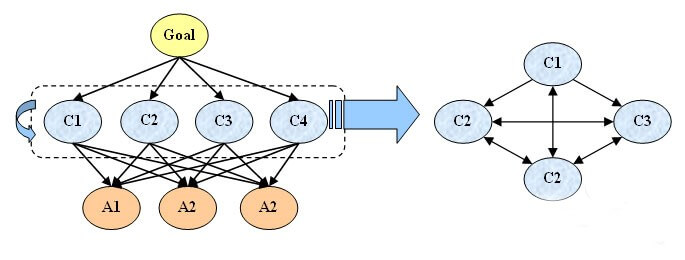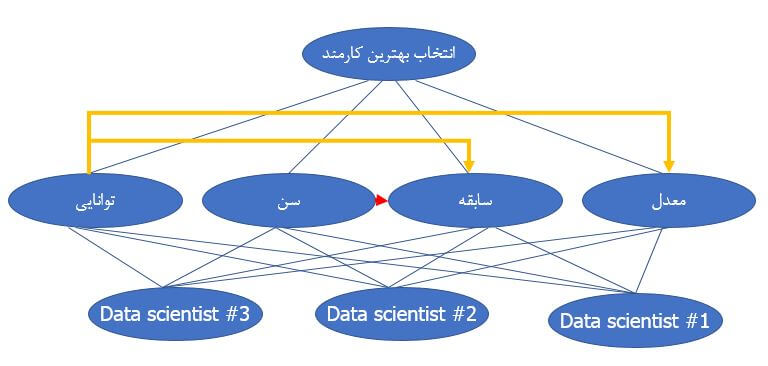The abbreviation ANP stands for “Analytical Network Process,” a method used for network analysis. ANP is a decision-making technique that shares significant similarities with the Analytic Hierarchy Process (AHP).
The ANP method, introduced by Thomas L. Saaty, aims to select appropriate options based on multiple criteria. It is also employed for weighting criteria and sub-criteria. In ANP’s network analysis process, pairwise comparisons are used to determine criterion weights.
Analytical Network Process Method
- Introduction to Multi-Criteria Decision Making and the Superiority of the ANP Method over Other Techniques.
- Teaching the Preparation of ANP Questionnaires.
- Calculating the Weights of Pairwise Comparison Matrices.
- Calculating the Inconsistency of Pairwise Comparison Matrices.
- Integrating Questionnaires When Multiple Experts’ Opinions Are Utilized.
- Manual Implementation of the ANP Method.
- Implementing the ANP Method in Expert Choice Software.
The ANP method, proposed by Saaty and Zaras in 1986, extends the AHP method. In situations where lower-level elements impact higher-level ones, or where elements on the same level are not independent, the hierarchical approach becomes less applicable. The ANP technique presents complex relationships among different decision levels in a network format, accounting for interactions and feedback among criteria and alternatives.

Internal Relationships Among Criteria
According to the model above, the four criteria C1 to C4 represent the primary decision-making criteria. These internal relationships indicate which criterion is more dependent on another, for example, how the first criterion relates to the second. The box with lines drawn around the criteria signifies the existence of internal relationships among all of them with each other, as mentioned in the previous sentence.
The Algorithm for the Analytical Network Process (ANP)
The Analytical Network Process (ANP) allows decision-makers to construct a network, enabling the examination of internal relationships among elements. The nodes within this network correspond to criteria or alternatives, and the branches connecting these nodes represent the degree of their interdependence. Determining the relationships within the network structure or assessing the mutual dependencies among criteria and alternatives is the most crucial aspect of the ANP method.
Relationships and dependencies can manifest as connections between different levels of the network, either external or internal. The relative importance of each member of the set – at its relevant level – is assessed through a series of pairwise comparisons, similar to the Analytic Hierarchy Process (AHP). Further instruction on ANP, along with a numerical example, will be provided in the following sections. For more detailed guidance on this technique, please download the ANP method package.
Teaching the ANP Method with a Simple Example
In this section, a two-level ANP example is presented, and for higher-level structures, you can refer to the ANP method package. A two-level scenario is one where we have criteria and alternatives, and if sub-criteria are also considered, it transforms into a three-level structure. Imagine you are selecting the best “Data Scientist” for your company from three candidates, and you also want to rank these three candidates. Below, the network structure for this problem is outlined.

Extracting Internal Relationships
To determine internal relationships using the ANP method, we answer the question of which factor’s change influences the change in another factor. If a change in the first factor leads to a change in the second factor, an arrow is drawn from the second factor to the first. In the example above, a high GPA and experience indicate high competency. Additionally, a high level of experience signifies older age.
Creating Pairwise Comparison Tables
If an arrow is drawn from one factor to more than one other factor, then a pairwise comparison table is formed among the factors that have the arrowhead pointing towards them relative to the factor at the arrow’s end. The questionnaire format for internal relationships and other tables differs. Below are tables showing inconsistency values and weights. It’s worth noting that the scores are determined based on the following scale (for more details, refer to the ANP method package).
با سلام
عذر میخوام نحوه خرید اموزشها به چه صورت هست؟ ایا اموزشها به صورتی سی دی ارسال میشن یا اجازه دسترسی جهت دانلود فایل به صورت انلاین و در لحظه داده میشه؟
مساله دیگه اینکه سایتتون نماد اعتماد الکترونیکی نداره…
سلام پرهام جان
تمامی آموزش های دیتا هارنسینگ به صورت فایل دانلودی هستند. شما میتوانید بعد از خرید این فایل ها را دانلود کنید. سی دی آموزش روش anp در دست اقدام است و زمانی که منتشر شد در وبسات قرار خواهیم داد.